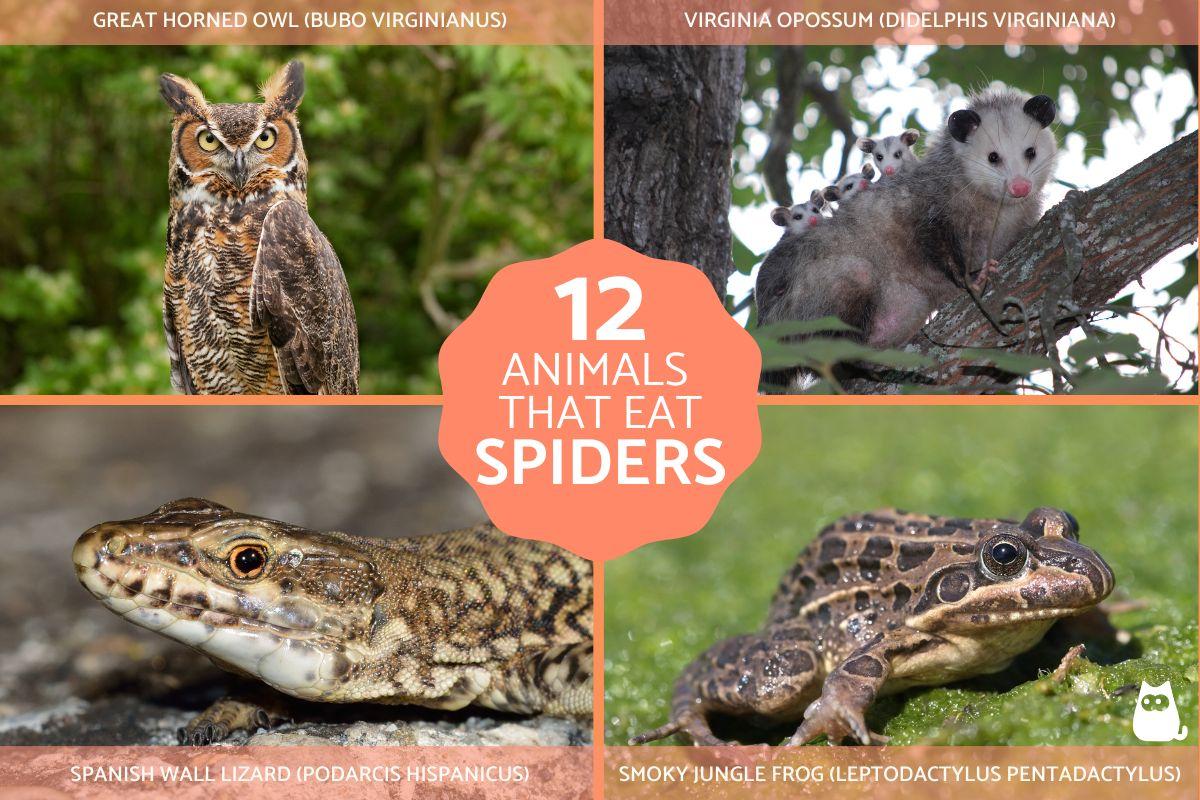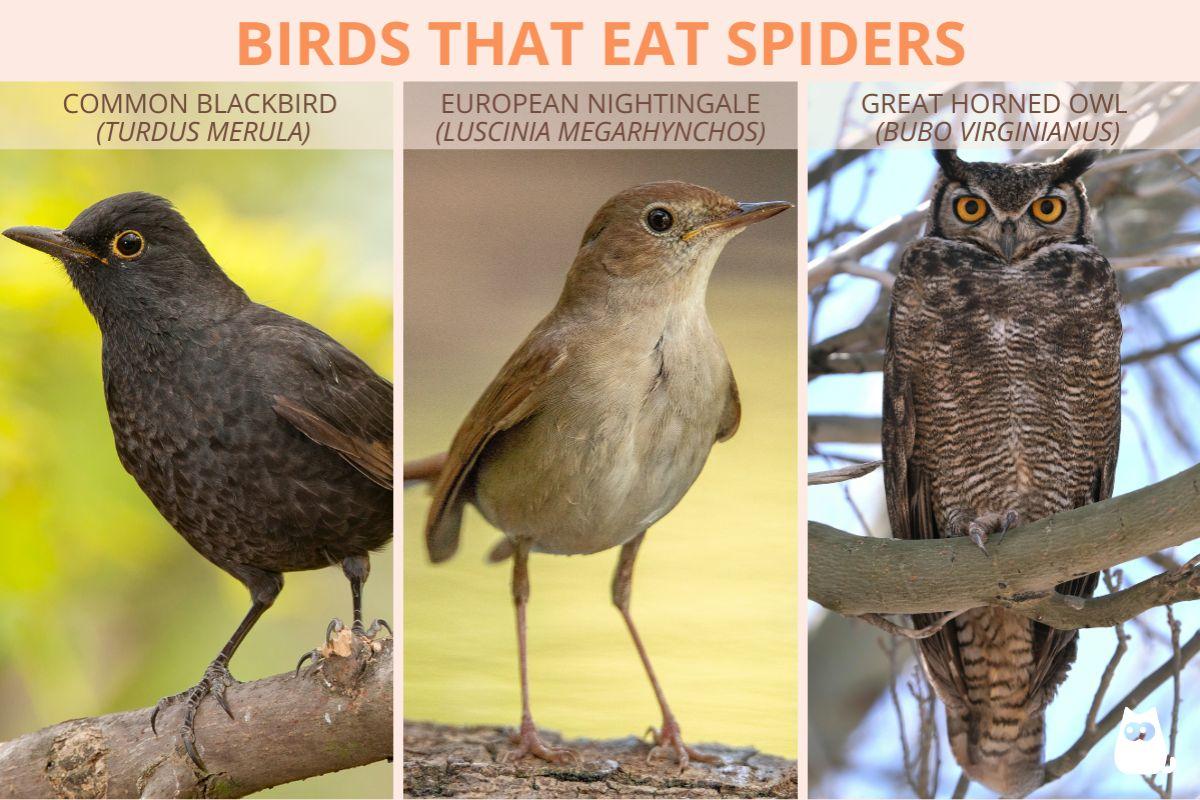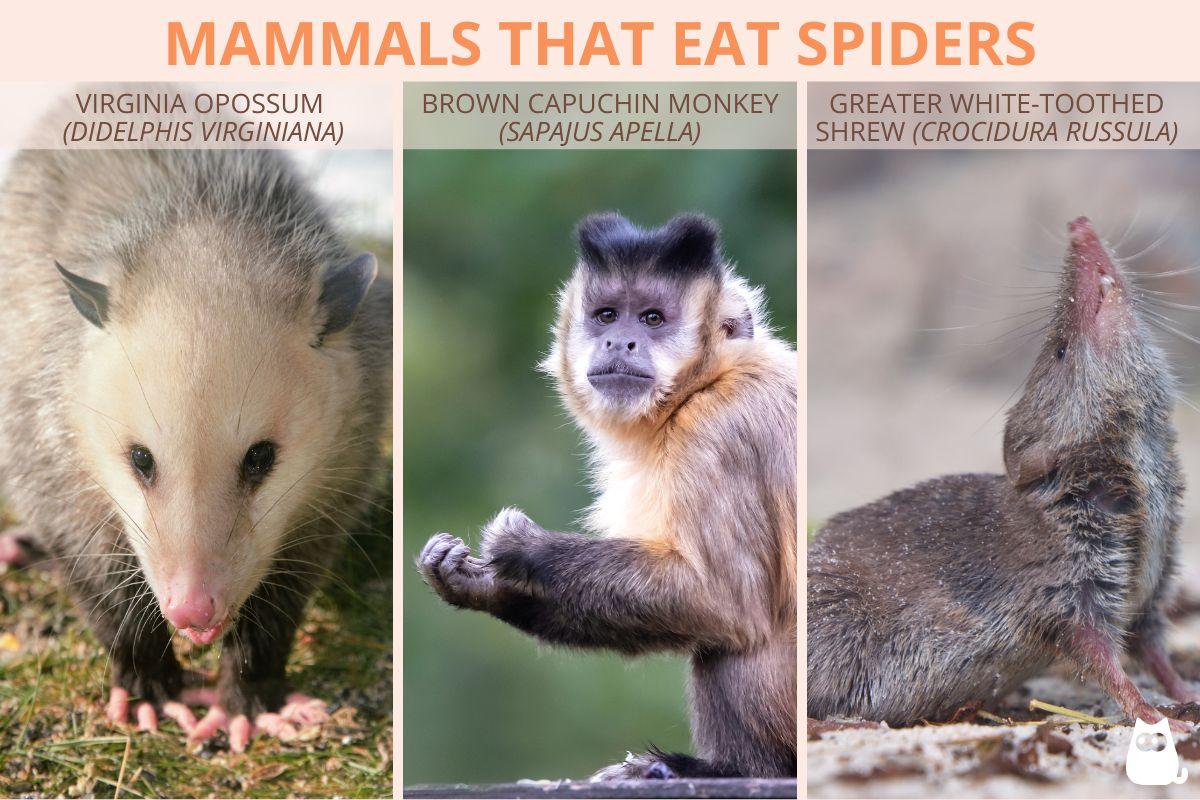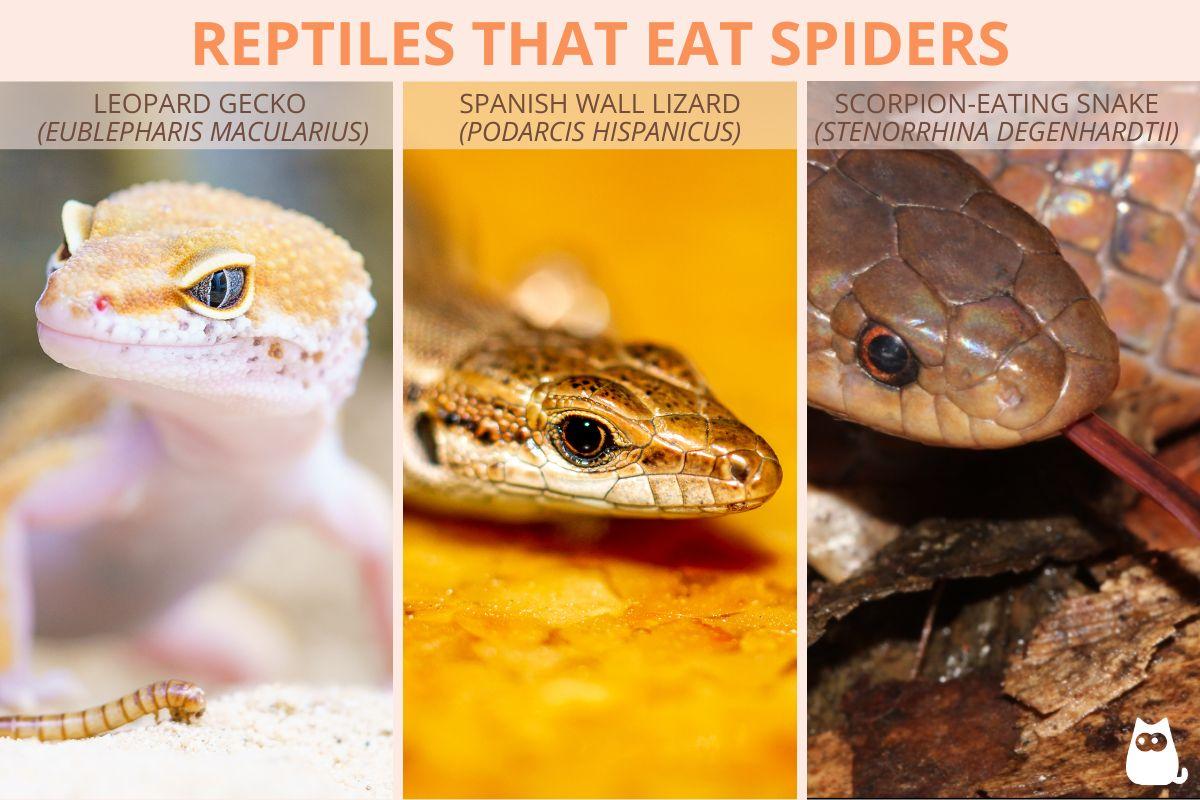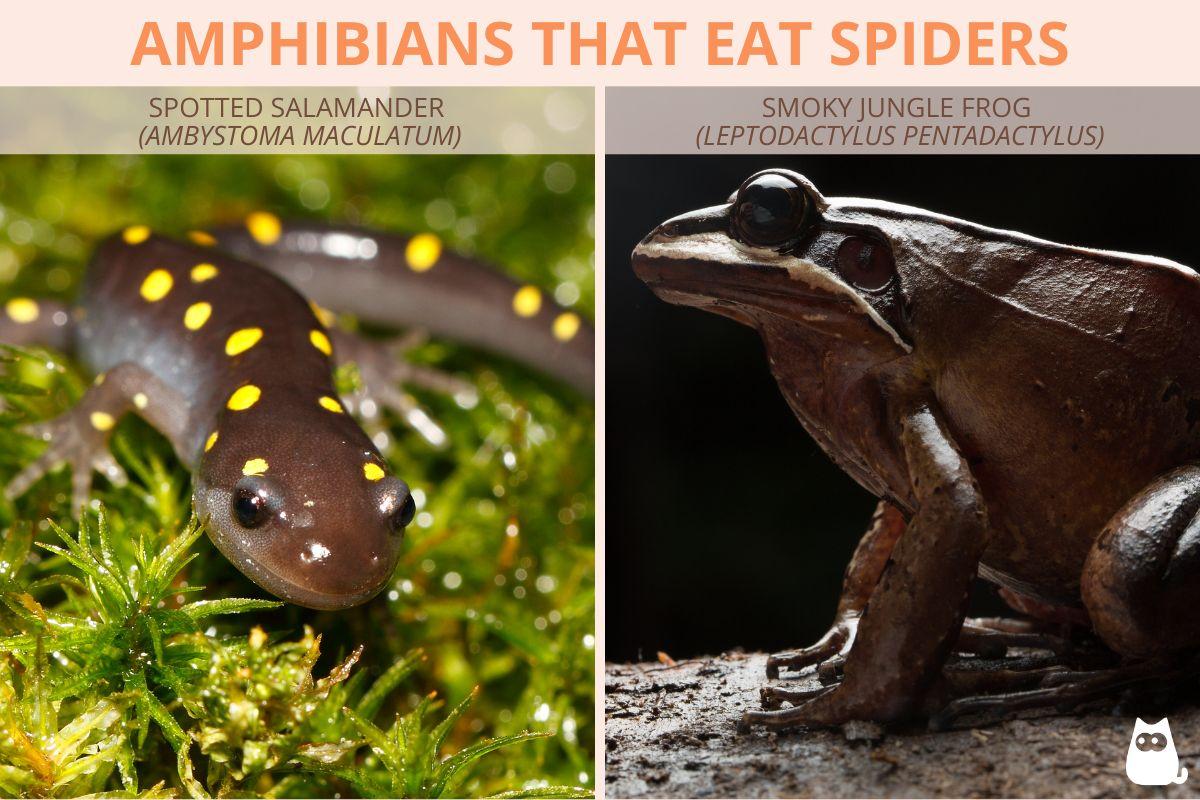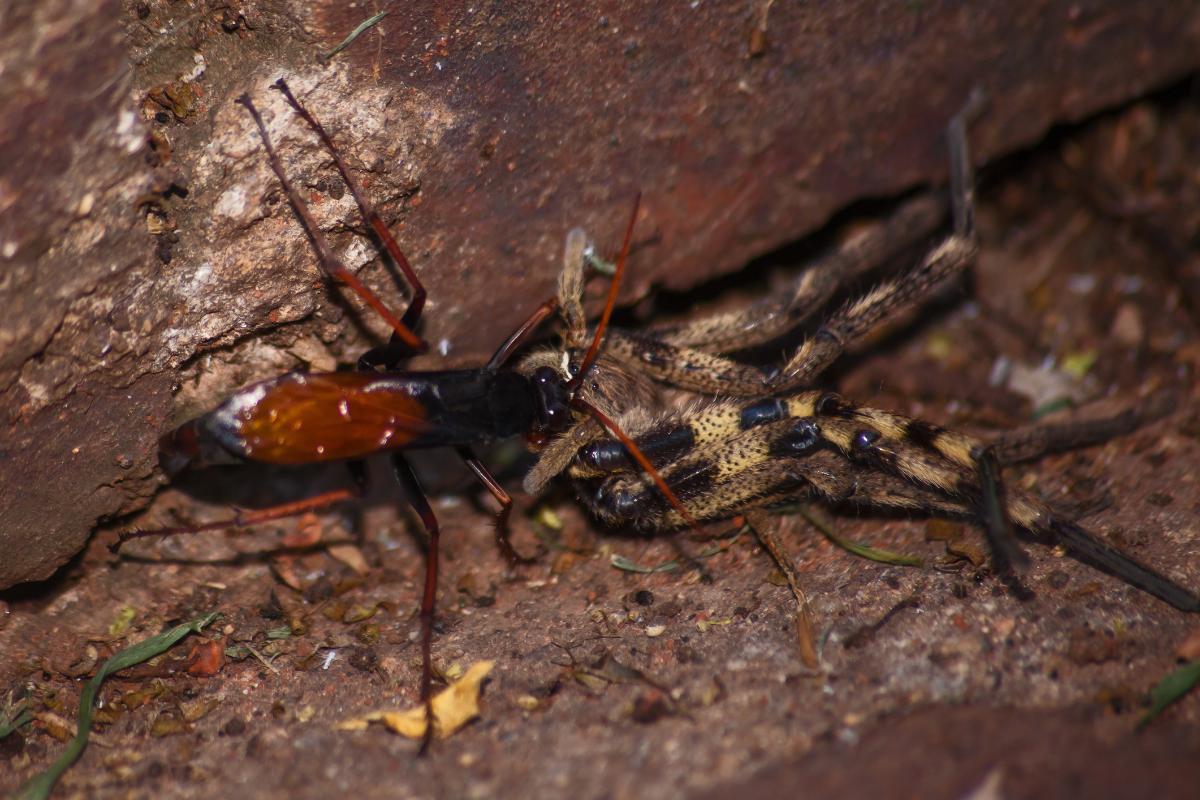Which Animals Hunt and Eat Spiders?

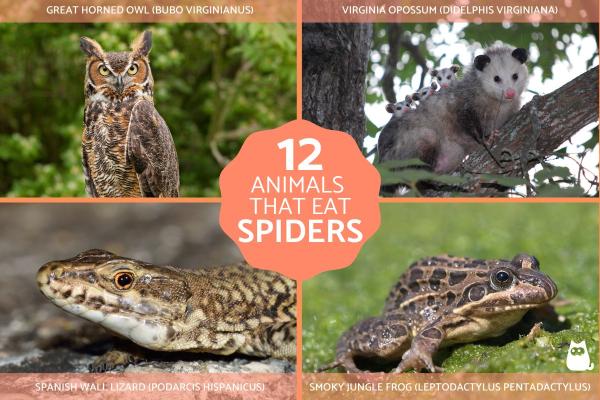
It's interesting to consider what eats spiders. Despite their predatory skills, spiders occupy a middle ground in the food web. They hunt insects and sometimes small animals, but they are also prey for a diverse range of creatures. From common birds and lizards to less expected predators, many animals consume spiders. So, while spiders hunt, they are also hunted by a variety of animals that have evolved to feed on these eight-legged creatures.
In this AnimalWisd article, we’ll explore 12 of the most common animals that hunt and eat spiders in the wild.
Birds that eat spiders
Birds are major spider predators worldwide. In fact, these feathered hunters have developed some impressive spider-catching skills. Let us take a look at some common examples:
Common Blackbird (Turdus merula):
The common blackbird stretches about 9.8 inches (25 cm) long and weighs around 3.6 ounces (102 g). Male blackbirds sport sleek black feathers with bright yellow beaks and eye rings. Females wear brown plumage instead.
These ground feeders prowl gardens and parks, flipping over leaves and digging through soil to find earthworms, insects, and spiders. They'll also snack on berries and seeds, and city-dwelling blackbirds sometimes grab human food scraps too.
Watch a blackbird in your garden, and you will notice how it will methodically work through mulch and leaf piles where garden spiders hide. Their hunting style makes them natural pest control agents in both city parks and countryside hedgerows. They've learned exactly where spiders like to hide and how to catch them efficiently.
European Nightingale (Luscinia megarhynchos):
The European nightingale wears modest brown feathers with lighter coloring underneath. Male and female nightingales look nearly identical, though males run slightly larger. These birds feast on ground insects such as beetles, ants, worms, grubs, and spiders make up their spring and summer menu. Come fall, they switch to berries and fruits. Most people know nightingales for their remarkable songs, often heard during evening hours.
Nightingales excel at nabbing spiders from low bushes and ground cover. They hop through thickets and brush, snatching spiders from their hiding spots. Their hunting keeps spider numbers in check along woodland boundaries and in shrubby areas.
Great Horned Owl (Bubo virginianus):
The great horned owl stands as one of North America's most impressive birds of prey. Its mottled brown and black feathers provide perfect camouflage, while piercing yellow eyes and distinctive feather tufts (the "horns") make it unmistakable.
These nighttime hunters eat almost anything they can catch: rodents, rabbits, birds, snakes, fish, and yes, even spiders when the opportunity presents itself.
Great horned owls rarely target spiders specifically, but they'll gobble them up when hunting in spider-rich areas. Their incredible night vision helps them spot even small movements in near-total darkness.
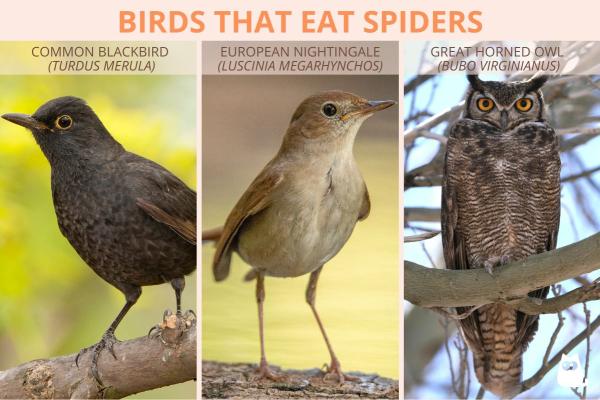
Mammals that eat spiders
Interestingly, a wide range of mammals also prey on spiders. From small insectivores like shrews to even some primate species, these predators also employ a variety of hunting techniques to secure their arachnid meals:
Virginia Opossum (Didelphis virginiana):
North America's only marsupial, the Virginia opossum, sports grayish-brown fur, a distinctive white face, and a nearly naked prehensile tail perfect for climbing. These adaptable creatures eat almost anything they can find from fruits, grains, roadkill, small animals, worms, insects, to spiders.
Opossums make excellent garden allies. Their insatiable appetite and curious nature drive them to poke through leaf piles, mulch, and garden debris, all prime spider real estate. A single opossum can devour countless spiders during its nightly wanderings through suburban and rural landscapes. They'll even climb trees to check for spiders in bark crevices and low branches.
Brown Capuchin Monkey (Sapajus apella):
The brown capuchin monkey has a stocky build with fur ranging from tan to nearly black. Its trademark "cap" of dark fur on top of its head gives it the capuchin name. These intelligent primates use their strong jaws and dexterous hands to access all kinds of food from fruits, nuts, seeds, small animals, eggs, to insects.
Capuchins actively hunt spiders during their daily foraging trips. They'll flip over dead leaves, tear apart rotting logs, and probe tree bark looking for hidden arachnids. Watch a group of capuchins move through the forest, and you'll hear their excited calls when someone finds a spider snack. Their nimble fingers can pluck spiders from webs without getting stuck, which is a hunting skill that takes young monkeys years to master.
Greater White-toothed Shrew (Crocidura russula):
The greater white-toothed shrew packs a lot of hunger into a tiny package, at just 2.4-3.5 inches (6-9 cm) long with reddish-brown or gray fur and a lighter-colored belly. These animals burn energy at an astonishing rate, forcing them to hunt almost constantly.
Shrews might be the most impressive spider hunters pound-for-pound. Their tiny size lets them squeeze into spider hideouts too small for other predators. A single shrew can eat more than its own body weight daily, and spiders make up a significant portion of that diet.
Their lightning-fast reflexes and keen sense of smell help them locate and capture spiders in seconds. Even venomous species aren't safe, many shrews have partial immunity to certain spider venoms.
Fascinated by the animal kingdom? Discover the incredible world of warm-blooded creatures that nurse their young in our comprehensive guide to nature's most diverse vertebrate class.
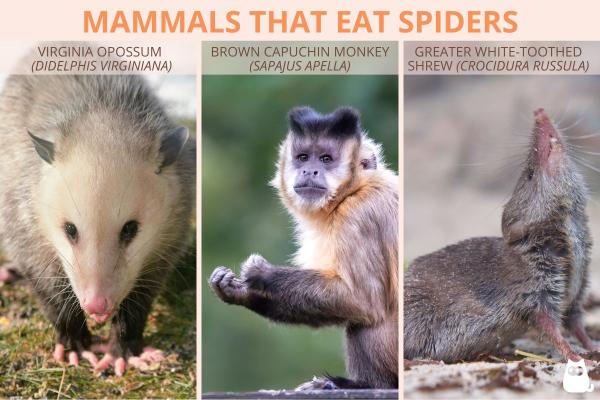
Reptiles that eat spiders
Reptiles join the spider-hunting club with some specialized skills. These cold-blooded predators have evolved perfect tools for finding and catching spiders. Let us take a closer look:
Leopard Gecko (Eublepharis macularius):
The leopard gecko grows to about 8-9 inches (22 cm) long with distinctive yellow skin covered in black spots. Pet trade breeding has created numerous color variations including bright yellow, albino, and various brown patterns. Unlike most geckos, leopard geckos have movable eyelids, actual claws instead of sticky toe pads, and a fat-storing segmented tail they can drop if grabbed by predators.
These desert-dwelling hunters come alive at night. Wild leopard geckos stalk through their arid habitats on the lookout for spiders, scorpions, beetles, and other invertebrates. Their hunting style involves a slow, deliberate stalk followed by a lightning-fast strike. Their night vision and heat-sensing abilities help them pinpoint spiders even in near-total darkness.
Spanish Wall Lizard (Podarcis hispanicus):
The Spanish wall lizard zips around Mediterranean countries at just 2-2.8 inches (50-70 mm) long, with a tail that doubles its overall length. These slender, flattened lizards wear gray to brown scales with dark patterns across their backs and sides. Their bellies range from plain white to vibrant orange, pink, or red depending on the individual.
Spanish wall lizards spend their days scampering up vertical surfaces hunting for food. Their small size lets them access tight crevices where spiders hide. They'll dash across sunny walls, stopping suddenly when they spot movement, then pounce on unfortunate spiders before they can escape. A single wall lizard might eat dozens of spiders daily during warm weather.
Scorpion-eating Snake (Stenorrhina degenhardtii):
The scorpion-eating snake stretches about 26 inches (65 cm) long and ranges from Mexico through Central America into northern South America. You'll find these specialized hunters in diverse habitats from sea level up to 9,200 feet (2,800 m) elevation.
This snake has evolved something remarkable, resistance to spider and scorpion venom. It actively seeks out these normally dangerous meals, using its keen sense of smell to locate hiding arachnids. The snake will systematically search rock crevices, leaf litter, and abandoned burrows for spiders. When it finds one, it strikes quickly, consuming venomous species that would kill other predators. Its diet mainly consists of spiders and scorpions, though it occasionally eats insects too.
If you found the scorpion-eating snake interesting, you'll be amazed to learn about the specialized breathing mechanisms that allow these creatures to thrive in diverse habitats.
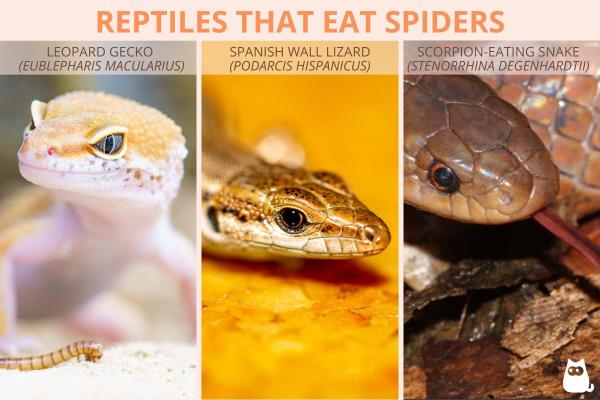
Amphibians that eat spiders
Amphibians love a good spider snack too. These moisture-loving creatures have unique hunting adaptations perfect for catching spiders:
Spotted Salamander (Ambystoma maculatum):
The spotted salamander grows 6-10 inches (15-25 cm) long with females typically outgrowing males. Their striking appearance features a black or dark brown body decorated with brilliant yellow or orange spots. The underside and lower legs show a lighter slate-gray coloration.
These forest-floor dwellers emerge on rainy nights to hunt. They use lightning-quick tongue strikes to capture spiders, worms, slugs, centipedes, and insects. Their hunting grounds happen to be prime spider real estate. A spotted salamander's sticky tongue can snatch a spider faster than the human eye can follow.
Smoky Jungle Frog (Leptodactylus pentadactylus):
One of the Americas' largest frogs, the smoky jungle frog, reaches an impressive 7 inches (18 cm) in length. Males typically grow slightly larger than females, which is unusual among amphibians. Their reddish-brown to cinnamon-colored skin features dark patterns and a distinctive stripe running down their back.
These monster frogs eat almost anything they can fit in their mouths. Large insects, spiders, other frogs, lizards, snakes, small birds, and even bats. Their powerful jaws and aggressive hunting style make them formidable predators in South American rainforests.
Unlike many smaller frogs that specialize in tiny prey, these giants tackle large, venomous spiders that other animals avoid. Their hunting strategy involves patient waiting followed by explosive lunges that give even fast-moving spiders little chance to escape.
Fascinated by the spotted salamander and smoky jungle frog? Discover the incredible diversity of these moisture-loving creatures in our comprehensive guide to these unique vertebrates.
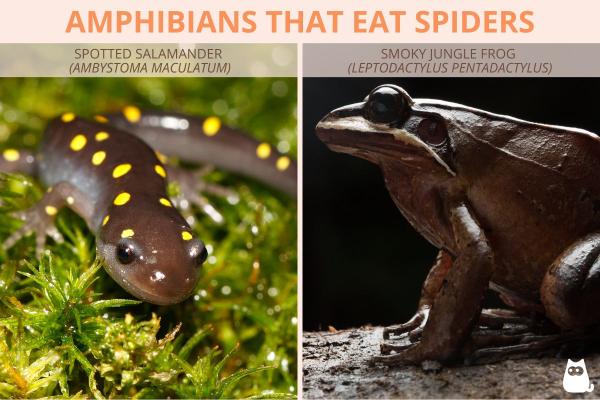
Insects that eat spiders
In a twist of fate, some insects turn the tables on spiders. These specialized hunters have evolved remarkable strategies to overcome spiders at their own game.
Spider Wasps (Pompilidae):
These wasps are surprisingly powerful fliers, and that's thanks to how their thorax is built. They often have these sleek, slender bodies that can be shiny blue or black, though some species have bright warning colors like red or orange. While the grown-up wasps mostly sip nectar from flowers, their babies have a much more intense way of eating.
Female wasps hunt down specific types of spiders, from big tarantulas to quick wolf spiders and even jumping spiders. When she finds one, she gives it this super precise sting that paralyzes it without killing it. Then, and this is where it gets a bit gruesome, she'll drag the still-alive spider to a nest she's made, lay a single egg on it, and seal it up. When the baby wasp hatches, it slowly eats the paralyzed spider, saving the important organs for last to keep it fresh.
What's really interesting is how different kinds of spider wasps have evolved their own special ways of hunting different spiders. Some can actually feel the tiny vibrations of spiders hiding underground, while others are experts at getting them out of their webs. This evolutionary battle that's been going on for millions of years has led to some of the most sophisticated hunting tricks in the insect world.
Ever wondered what makes spiders such efficient hunters themselves, before they fall prey to the animals in this article? Discover the intricate structure of these arachnids in our popular feature.
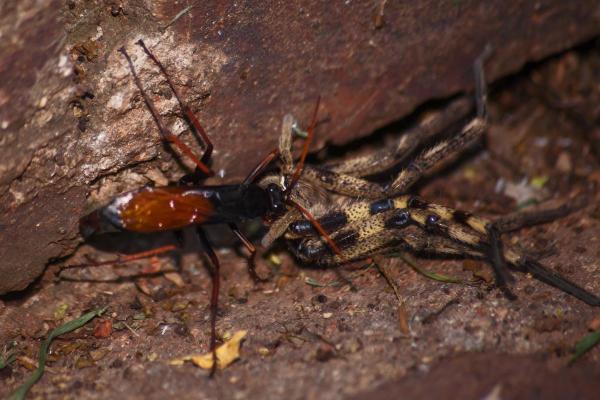
If you want to read similar articles to Which Animals Hunt and Eat Spiders?, we recommend you visit our Facts about the animal kingdom category.
- Animal Diversity Web. (2020). Available at: https://animaldiversity.org/





